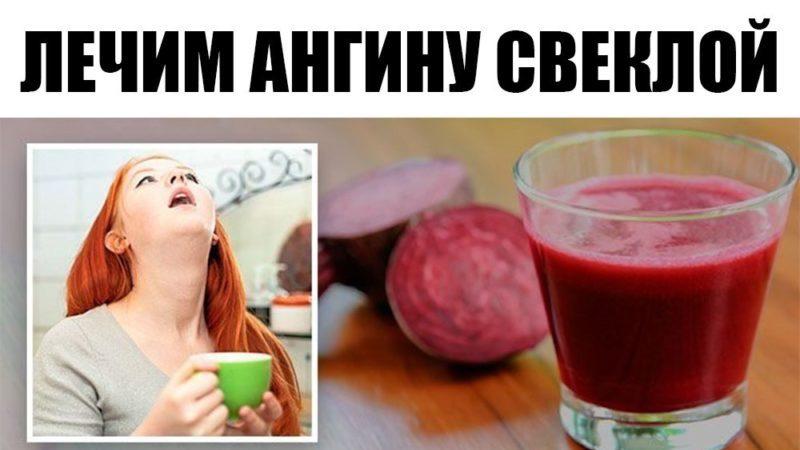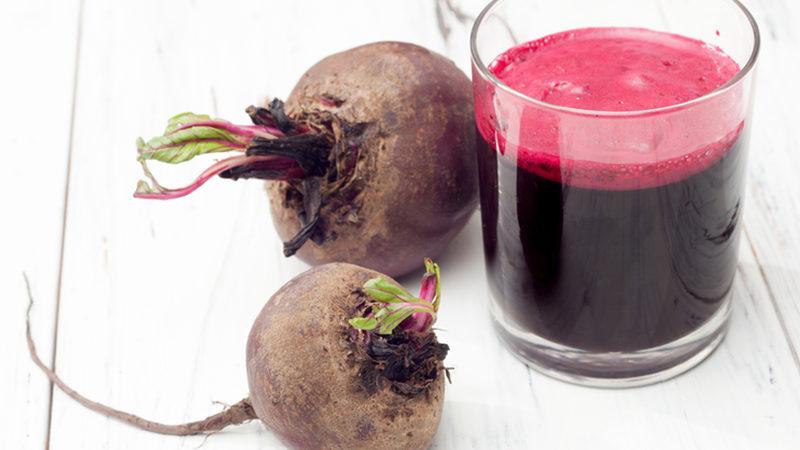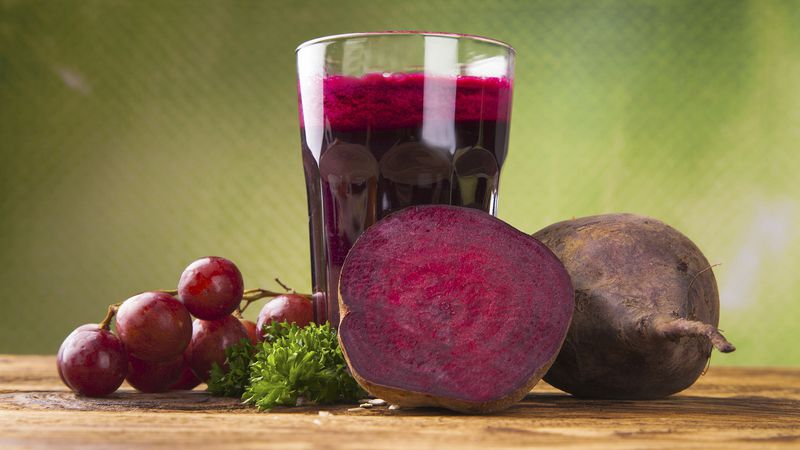Alternative treatment with natural ingredients: will beets with vinegar help from angina and how to use it correctly
Medicinal plants grow in our gardens. One of them is beet, which is used to treat many diseases, including tonsillitis. Is this remedy really effective? Does it have contraindications and do practitioners approve of this method of treatment? You will receive detailed answers to these questions in our article.
The content of the article
Beetroot with vinegar to gargle
Folk remedies have been used for centuries in the treatment of tonsillitis. However, it is important to understand that angina is treated exclusively with the procedures and medications prescribed by the doctor. Do not blindly trust reviews about the effectiveness of rinsing alone. Throat sanitation is just an additional way of influencing the main therapy.
The principle of action in the fight against angina
Gargling is one of the most effective treatments for sore throat. Tonsillitis, regardless of the nature of its manifestation, requires rinsing the mouth and pharynx with pharmaceuticals.
You can supplement them folk methods using beets.

The beneficial properties of beets are due to their rich chemical composition. It includes sucrose, fructose, glucose.
Among the mineral salts, it is worth highlighting:
- potassium;
- magnesium;
- calcium;
- iron;
- phosphorus;
- zinc;
- manganese;
- cobalt.
The beneficial properties of the root crop are enhanced by apple, citric, oxalic, tartaric acid and vitamins C, B1, B2, B3, B5, B6, U, P, PP, carotene.
The characteristics of beets are improved by the presence in its composition of iodine, pantothenic, folic and oleanolic acids, as well as at least a dozen different amino acids, including lysine, valine, arginine and histidine.
The unique properties of beetroot juice strengthen the body and thereby help fight infection, as well as:
- stop the inflammatory process;
- reduce pain;
- eliminate swelling and flushing of the throat;
- increase local immunity;
- saturate the body with useful macro- and micronutrients;
- strengthen the walls of blood vessels and improve local blood circulation;
- contribute to the flushing of purulent plugs.
Acetic acid enhances the therapeutic effect of beets. The main effect of vinegar is antimicrobial, which is why beets with vinegar for sore throat are so popular among the population.
The benefits and harms of this treatment
Throat sanitation with vinegar and beet juice is used for acute respiratory viral infections and other diseases accompanied by an inflammatory process in the throat. The use of this method is due to the availability and safety of the components used.
Among the advantages of rinsing is the hypoallergenicity of the product - it is well tolerated and does not cause discomfort. The benefits of the drug are manifested in moisturizing the mucous membrane, flushing out purulent exudate and preventing the appearance of tonsillitis plugs.
The use of a folk remedy for chronic tonsillitis is also significantly expressed, when there is a decrease in immunity, and not re-infection with an infection.
With the help of beets and vinegar, it is impossible to destroy the causative agent of the disease, because antimicrobial and antiseptic effect is weak.Therefore, negative consequences should be expected only if you use folk remedies as monotherapy.
Important! Treatment of tonsillitis and other infectious diseases of the throat should be etiotropic, that is, aimed at eliminating the causes.
Beetroot gargle recipes

In addition to the simplicity of preparing medicinal mixtures, various options for their use are also captivating: inhalations, rinses, compresses. The general condition of the patient, the type of disease predetermine further treatment tactics.
Making juice and beetroot broth
Beetroot juice can be used as an independent remedy. For cooking, choose root vegetables of a bright reddish color, if possible, elongated.
Preparation:
- Wash the vegetable, remove the tops, cut off ¼ part of the top.
- Grate and strain through cheesecloth or chop in a blender.
- Pour the juice into a glass container and let it brew for 2 hours.
- During this time, white foam will form on the surface of the juice, it must be removed.
Pure juice should be taken with caution, gradually increasing the dose (start with 50 g). You can dilute the juice with water in a 1: 1 ratio.
Beetroot broth is used for inhalation and rinsing. Inhalation of beneficial steam helps to reduce pain, eliminates perspiration and discomfort when swallowing.
Algorithm of actions:
- Wash the root vegetables thoroughly, boil until tender.
- Breathe over the steam for at least 10 minutes.
- Add a few drops of essential oil if desired.
With systematic rinsing, the infiltrates are resorbed and the inflamed tissues heal. To prepare a decoction for rinsing, you need to rinse 200-300 g of vegetables, peel and boil until tender. Allow to cool to 20 ° C and add 1 tsp each. propolis per 1 liter of broth.
For reference. Beetroot juice is an excellent base for nasal drops. The tool is not addictive and does not injure the mucous membrane. For adults, use a concentrate of beetroot juice, for children - dilute with water 1: 2.
Beetroot and apple cider vinegar recipe for sore throat
A simple yet effective recipe. Grate medium-sized root vegetable, squeeze out the juice. Add 1 tbsp. l. apple cider vinegar, stir and leave in a dark place for 3-4 hours. Then strain. The maximum rinse rate is 3 times a day. Not suitable for children under 10 years of age.
Beet, honey and cranberry tincture recipe
For this recipe, freshly prepared beet and cranberry juice are mixed in equal proportions. Add ½ part boiled water and the same amount of honey. Mix thoroughly, use 5-7 times a day.
Recipes for children

There are no recipes specifically for children. The treatment options are the same as for adults, only in a reduced dosage and concentration of beetroot juice. Before starting treatment, you should consult a pediatrician. The procedures begin only in the absence of individual intolerance and other contraindications.
Children over 5 years old can gargle on their own, under the supervision of their parents. The medicinal mixture is diluted in equal proportion with water.
It is more convenient for young children to handle the tonsils with a regular syringe (without a needle). If a small child does not tolerate the rinsing procedure, it can be replaced with plenty of drinking, the effect will be the same.
Treatment of young children (under 3 years old) with beets is limited exclusively to compresses, other methods are undesirable, since side effects may occur due to an early age. After 3 years, you can already use all methods of taking beets or beet broth.
Gargle procedure
It is impossible to cure a sore throat with just rinsing, but you can enhance the effectiveness of the procedure by observing the rules for its implementation:
- Rinsing is carried out 30 minutes before / after meals.
- The head is thrown back as much as possible, while rinsing, pronounce a lingering sound "A".
- It is necessary to collect liquid in the mouth with a volume of one sip.
- It is important to monitor your breathing to avoid getting into the wrong throat.
- The duration of rinsing is 4-5 minutes, the frequency is up to 6 times a day.
- Rinse solutions should be as fresh and warm as possible.
With the help of local treatment, you can eliminate the symptoms, relieve the patient's condition. Antibiotics are needed to clear the infection.
How to inhale
You can breathe the decoction from the root vegetable in two ways: over a saucepan or through a kettle. The second method is more convenient to use. Twist a funnel made of thick paper, insert it into the spout of the kettle and begin to inhale the steam.
You cannot breathe over boiling water, this can lead to burns of the respiratory tract. After boiling water, wait 5-10 minutes.
Attention! At elevated body temperatures, inhalation can be harmful.
In diseases of the middle respiratory tract (throat, larynx), inhale and exhale through the mouth. You should breathe calmly as usual.
The procedure is carried out an hour and a half after a meal. After inhalation, it is forbidden to take food and drinks for 30-40 minutes, it is also not recommended to talk and go outside.
Compress
It is possible to start applications on the throat only if there are no contraindications and with the permission of a doctor. A medical bandage can provoke complications at a high temperature, therefore, with an increase in subfebrile parameters, the procedure cannot be performed.
To apply a compress you will need:
- Prepare the base: roll the gauze or cotton cloth in several layers.
- Saturate the base with a medicinal solution and apply a compress to the affected area.
- Cover the applique with polyethylene on top.
- Warm the compress with a woolen scarf or towel.
Avoid applying a compress to the thyroid and peri-maxillary lymph nodes. Keep the medical application for 1 to 3 hours.
Important! This method of treatment is prohibited for allergic rashes and dermatitis, oncological diseases, pathologies of the cardiovascular system, fever and thrombophlebitis.
To prepare the medicinal mixture, grate the root crop, squeeze. The liquid is removed or used for rinsing, and the cake is wrapped in gauze. Adding onions will increase the effectiveness of the compress.
Contraindications to treatment with beets for angina

The use of beets, vinegar and other ingredients may cause irritation to the throat mucosa. In addition, swallowing solutions with such additives is unsafe for patients:
- with individual intolerance;
- stomatitis;
- gastritis with high acidity;
- urolithiasis;
- severe diabetes mellitus;
- other diseases of the oral cavity.
It is used with caution to treat children up to the age of six.
Is it possible for pregnant and lactating
Internal intake of beets during pregnancy and lactation is undesirable. The substances contained in the root vegetable can be misinterpreted by the body against the background of hormonal disruptions and lead to an allergic reaction in both the mother and the child.
With other methods of treating beets, the period of pregnancy and lactation does not cause prohibitions. Provided you feel satisfactory at the time of the procedure.
The effectiveness of treatment and recommendations of specialists
An unreasonable preference for local treatment can lead to complications. The antimicrobial and antiseptic effect of beets is inferior to most pharmacological agents. The opinions of experts in this matter are unambiguous: beet juice cannot be an alternative to medications in the treatment of tonsillitis.
As an auxiliary therapy, with a mild course of the disease or with a chronic form, doctors do not prohibit the use of a folk remedy, but only after assessing the patient's condition.
Read also:
How to breathe correctly over potatoes with sinusitis and is it possible to do it.
Beetroot juice for sinusitis: choose a recipe and apply it correctly.
We save children from the common cold: onion juice nasal drops.
Conclusion
Treatment of angina with beets can be used as an adjunct to conservative therapy. Do not neglect the consultation of a specialist: the unconventional method has a number of contraindications. It is important to understand that traditional medicine is not effective in all cases. In some cases, self-treatment becomes the cause of complications.
As a mucous membrane moisturizer, to flush out purulent foci and prevent the formation of crusts, gargling with a beetroot solution is an effective procedure, but this remedy will not help in the fight against the pathogen.